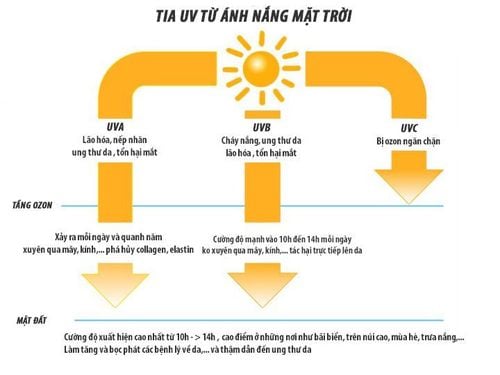This article was medically reviewed by Associate Professor, PhD, MD Huynh Thoai Loan - Head of Pediatrics and Neonatology Department, Vinmec Central Park International General Hospital. She is one of the leading experts in Pediatrics and Neonatology in Ho Chi Minh City, with nearly 30 years of experience in diagnosing and treating endocrine disorders in children, pediatric nephrology, and other pediatric and neonatal issues.
Up to 80% of the vitamin D required by the body is synthesized through daily direct exposure to sunlight. However, excessive or improper sun exposure can be detrimental. Inadequate timing, incorrect methods, or prolonged sun exposure can lead to skin damage, particularly in the sensitive skin of neonates and young children.
1. Types of solar rays
To determine the best time for sunbathing, it is essential to understand the roles of different types of solar rays in the process of vitamin D synthesis, which will help identify which rays are harmful and which are beneficial for the skin.
Sunlight consists of visible rays (the rainbow) and invisible rays, specifically ultraviolet (UV) rays. UV rays are classified into three types: UVC, UVA, and UVB.
UVC Rays: These have a short wavelength of approximately 200 - 190 nm. UVC rays are the most harmful to human health. However, they are absorbed by the ozone layer before reaching the Earth's surface, so they have little to no effect on the skin and do not contribute to vitamin D synthesis.
UVA Rays:
- Comprising 95% of the total UV radiation that reaches the Earth's surface, UVA rays have the longest wavelength, ranging from approximately 320 - 400 nm.
- UVA rays can penetrate the ozone layer, clouds, water, glass, and thin clothing. In fact, some sunscreens may not effectively block UVA rays. Therefore, UVA rays are present throughout the duration of sunlight exposure, even on cloudy or rainy days.
- UVA rays are responsible for skin darkening, aging, pigmentation, freckles, and increasing the risk of skin cancer. Similar to UVC rays, UVA rays do not contribute to vitamin D synthesis.
UVB Rays:
- These are the only rays in sunlight that can stimulate the precursor of vitamin D and support calcium absorption in the human body.
- UVB rays have a shorter wavelength than UVA rays, ranging from approximately 290 - 320 nm. About 95% of UVB rays are absorbed by the ozone layer, with only a small fraction reaching the Earth's surface.

2. What is the best time to sunbathe?
UVB rays are the only rays capable of synthesizing vitamin D, which is beneficial for health, so it is important to choose a time when UVB rays are most abundant for sunbathing.
The time when UVB rays can penetrate the ozone layer the most is approximately from 9 AM to 4 PM. However, during this period, there are also many harmful UVA rays present, especially for the delicate skin of infants and young children.
Therefore, the best times for sunbathing are before 9 AM and after 4 PM, when the sunlight is not too intense.
3. How long is it sufficient to sunbathe?

Although UVB rays can stimulate the synthesis of vitamin D, prolonged exposure to UVB rays or exposure at high intensities can also be harmful to the skin. Therefore, sunbathing should not be excessive. It is recommended to sunbathe for about 20 to 30 minutes per session, depending on the intensity of sunlight exposure on the skin. For infants, the initial sun exposure should be limited to approximately 10 minutes, gradually increasing the duration as they become accustomed.
Unlike UVA rays, UVB rays cannot penetrate clothing or glass, so when sunbathing, the skin should be exposed directly to sunlight, and children should not sunbathe through windows. Clothing can be gradually removed, starting with the feet, then the calves, thighs, followed by the hands, forearms, and finally the back.
It is important to note that sun exposure provides only about 80% of the necessary vitamin D for the body. Therefore, it is essential to supplement vitamin D for children through breast milk and daily food intake. Additionally, parents may consider giving children vitamin D3 supplements in appropriate dosages according to their age and the manufacturer's guidelines.
To arrange an appointment, please call HOTLINE or make your reservation directly HERE. You may also download the MyVinmec app to schedule appointments faster and manage your reservations more conveniently.








